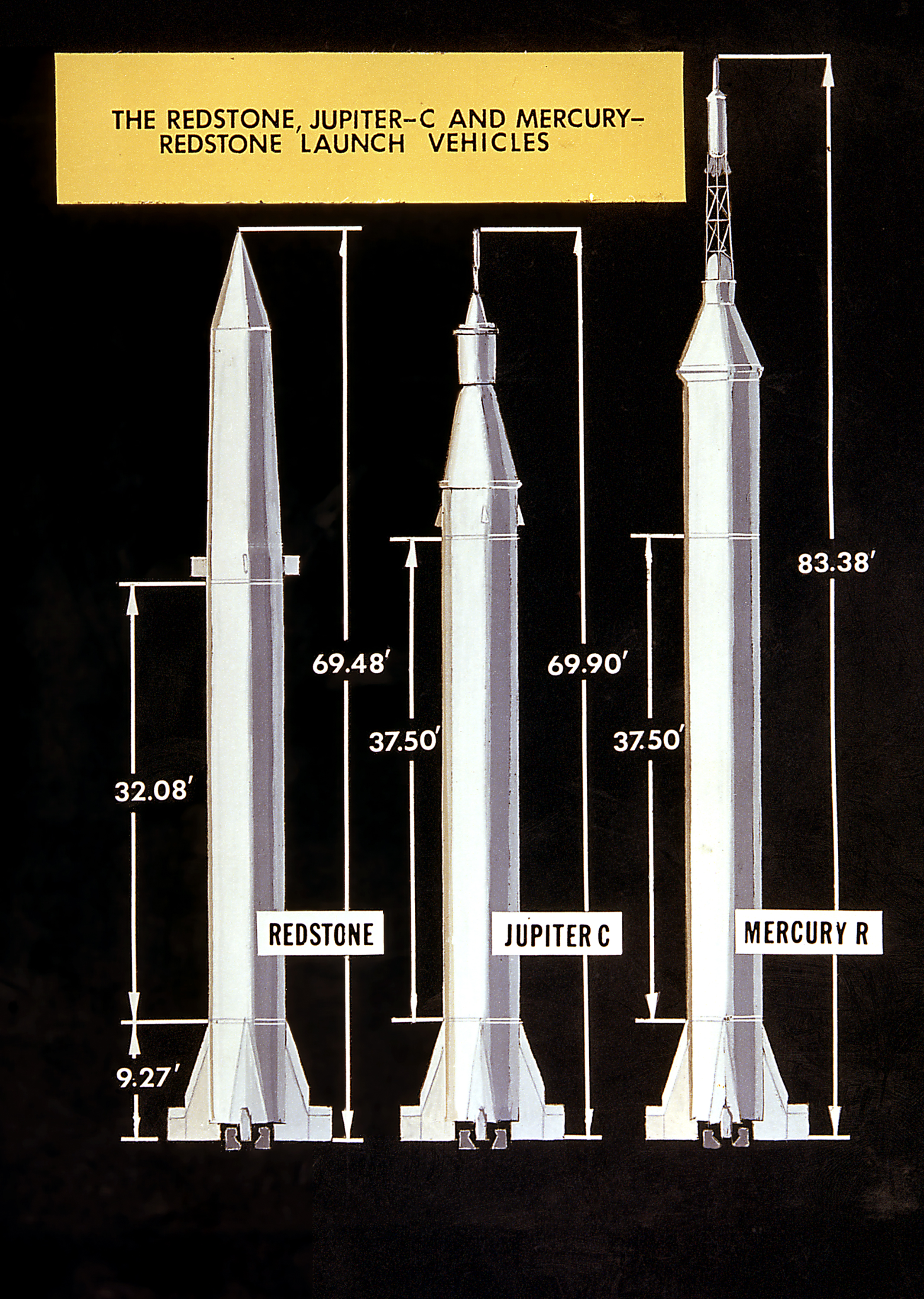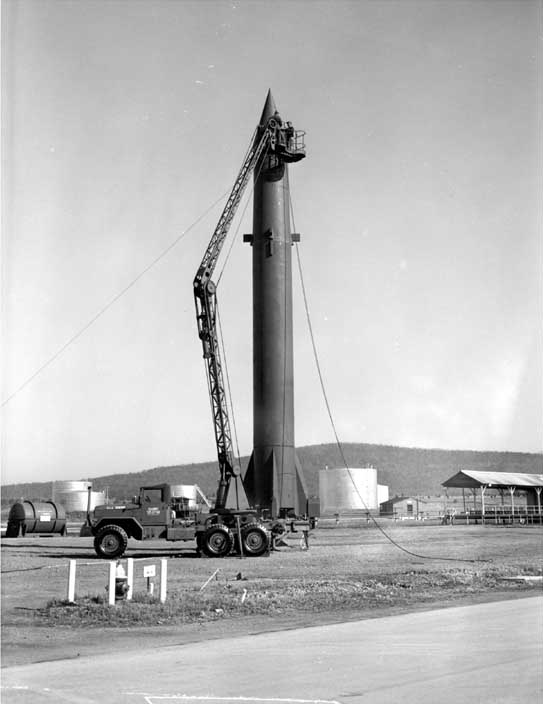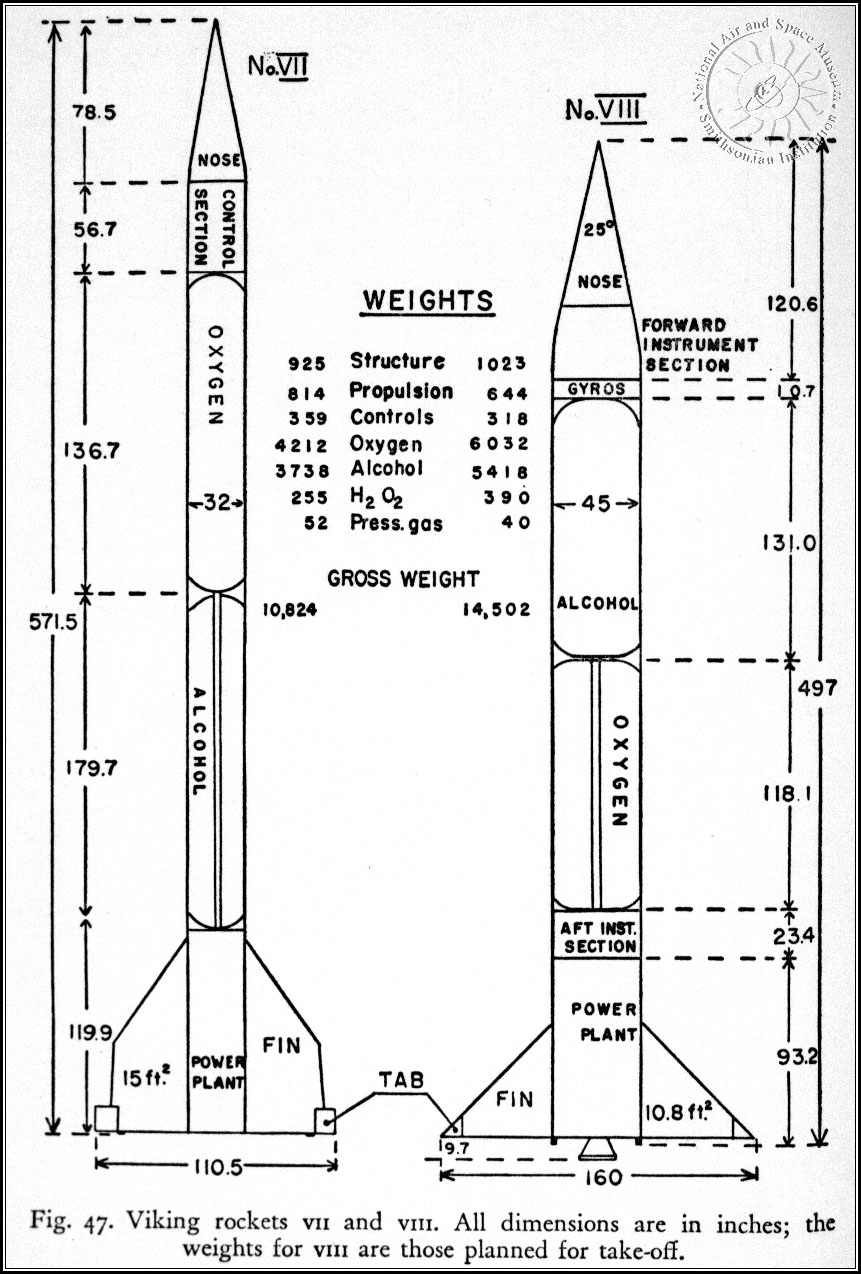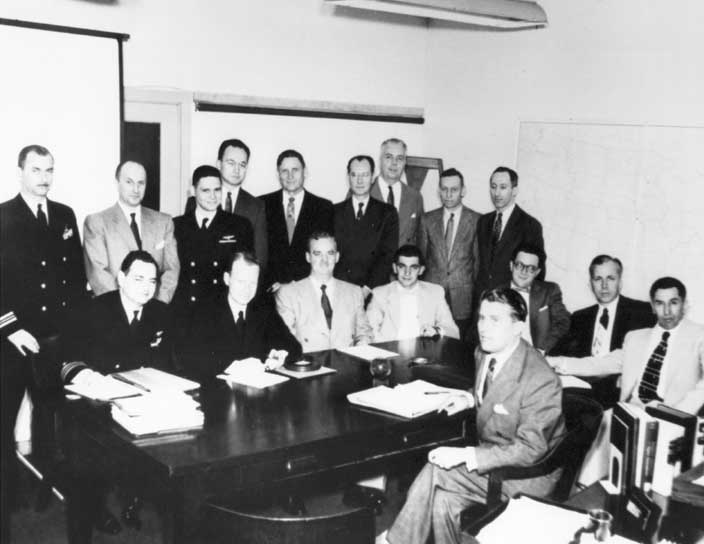|
Jupiter C
The Jupiter-C was an American research and development vehicle developed from the Jupiter-A. Jupiter-C was used for three unmanned sub-orbital spaceflights in 1956 and 1957 to test re-entry nosecones that were later to be deployed on the more advanced PGM-19 Jupiter mobile missile. The recovered nosecone was displayed in the Oval Office as part of President Dwight D. Eisenhower's televised speech on November 7, 1957. A member of the Redstone rocket family, Jupiter-C was designed by the U.S. Army Ballistic Missile Agency (ABMA), under the direction of Wernher von Braun. Three Jupiter-C flights were made followed by three satellite launches (Juno I). All were launched from Cape Canaveral, Florida. Description Each vehicle consisted of a modified Redstone ballistic missile with two solid-propellant upper stages. The tanks of the Redstone were lengthened by 8 ft (2.4 m) to provide additional propellant. The instrument compartment was also smaller and lighter than the Reds ... [...More Info...] [...Related Items...] OR: [Wikipedia] [Google] [Baidu] |
Cape Canaveral Air Force Station
Cape Canaveral Space Force Station (CCSFS) is an installation of the United States Space Force's Space Launch Delta 45, located on Cape Canaveral in Brevard County, Florida. Headquartered at the nearby Patrick Space Force Base, the station is the primary launch site for the Space Force's Eastern RangeCAST 1999, p. 1-12. with three launch pads currently active (Space Launch Complexes 37B, 40, and 41). The facility is south-southeast of NASA's Kennedy Space Center on adjacent Merritt Island, with the two linked by bridges and causeways. The Cape Canaveral Space Force Station Skid Strip provides a runway close to the launch complexes for military airlift aircraft delivering heavy and outsized payloads to the Cape. A number of American space exploration pioneers were launched from CCSFS, including the first U.S. Earth satellite (1958), first U.S. astronaut (1961), first U.S. astronaut in orbit (1962), first two-man U.S. spacecraft (1965), first U.S. unmanned lunar lan ... [...More Info...] [...Related Items...] OR: [Wikipedia] [Google] [Baidu] |
Army Ballistic Missile Agency
The Army Ballistic Missile Agency (ABMA) was formed to develop the United States Army, U.S. Army's first large ballistic missile. The agency was established at Redstone Arsenal on 1 February 1956, and commanded by Major General John Bruce Medaris, John B. Medaris with Wernher von Braun as technical director. History The Redstone (rocket), Redstone missile was the first major project assigned to ABMA. The Redstone was a direct descendant of the V-2 missile developed by the von Braun team in Germany during World War II. After the Naval Research Laboratory's Project Vanguard was chosen by the United States Department of Defense, DoD Committee on Special Capabilities, over the ABMA's proposal to use a modified Redstone (rocket), Redstone ballistic missile as a satellite launch vehicle, ABMA was ordered to stop work on launchers for satellites and focus, instead, on military missiles. Von Braun continued work on the design for what became the Jupiter-C rocket. This was a three-st ... [...More Info...] [...Related Items...] OR: [Wikipedia] [Google] [Baidu] |
Clear Text
In cryptography, plaintext usually means unencrypted information pending input into cryptographic algorithms, usually encryption algorithms. This usually refers to data that is transmitted or stored unencrypted. Overview With the advent of computing, the term ''plaintext'' expanded beyond human-readable documents to mean any data, including binary files, in a form that can be viewed or used without requiring a key or other decryption device. Information—a message, document, file, etc.—if to be communicated or stored in an unencrypted form is referred to as plaintext. Plaintext is used as input to an encryption algorithm; the output is usually termed ciphertext, particularly when the algorithm is a cipher. Codetext is less often used, and almost always only when the algorithm involved is actually a code. Some systems use multiple layers of encryption, with the output of one encryption algorithm becoming "plaintext" input for the next. Secure handling Insecure handling of p ... [...More Info...] [...Related Items...] OR: [Wikipedia] [Google] [Baidu] |
Viking Rocket
Viking was series of twelve sounding rockets designed and built by the Glenn L. Martin Company under the direction of the U.S. Naval Research Laboratory (NRL). Designed to supersede the German V-2, the Viking was the most advanced large, liquid-fueled rocket developed in the United States in the late 1940s, returning valuable scientific data from the edge of space between 1949 and 1955. Viking 4, launched in 1950, was the first sounding rocket to be launched from the deck of a ship. After twelve flights, the Viking was adapted into the first stage for the Vanguard rocket, which launched America's second satellite into orbit in 1958. Origins After World War II, the United States experimented with captured German V-2 rockets as part of the Hermes program. Based on these experiments the U.S. issued a contract 21 August 1946 to the Glenn L. Martin Company for a series of ten large liquid-fueled rockets. The intent was to provide an independent U.S. capability in rocketry, to co ... [...More Info...] [...Related Items...] OR: [Wikipedia] [Google] [Baidu] |
Vanguard Rocket
The Vanguard rocket was intended to be the first launch vehicle the United States would use to place a satellite into orbit. Instead, the Sputnik crisis caused by the surprise launch of Sputnik 1 led the U.S., after the failure of Vanguard TV-3, to quickly orbit the Explorer 1 satellite using a Juno I rocket, making Vanguard 1 the second successful U.S. orbital launch. Vanguard rockets were used by Project Vanguard from 1957 to 1959. Of the eleven Vanguard rockets which the project attempted to launch, three successfully placed satellites into orbit. Vanguard rockets were an important part of the Space Race between the United States and the Soviet Union. Overview In 1955, the United States announced plans to put a scientific satellite in orbit for the International Geophysical Year (IGY) in 1957–1958. The goal was to track the satellite as it performed experiments. At that time, there were three candidates for the launch vehicle: The Air Force's SM-65 Atlas, a derivative of ... [...More Info...] [...Related Items...] OR: [Wikipedia] [Google] [Baidu] |
Project Orbiter
Project Orbiter was a proposed United States spacecraft, an early competitor to Project Vanguard. It was jointly run by the United States Army and United States Navy. It was ultimately rejected by the Ad Hoc Committee on Special Capabilities, which selected Project Vanguard instead. Although the project was canceled on 3 August 1955, the basic design was used for the Juno I rocket which launched Explorer 1, the first satellite launched by the United States. Proposal In the 1920s and 1930s, the German Society for Space Travel (''Verein für Raumschiffahrt,'' referred to as ''VfR'' by its founders) began to gain in popularity, with membership growing from outside of Germany as well as within. The primary cause for the ''VfR's'' gaining worldwide appeal was due to the writings of mathematician Hermann Oberth who detailed, in a 1923 publication entitled ''The Rocket into Interplanetary Space'', the mechanics of placing a satellite into Earth orbit. Herman Potočnik was the first ... [...More Info...] [...Related Items...] OR: [Wikipedia] [Google] [Baidu] |
Apogee
An apsis (; ) is the farthest or nearest point in the orbit of a planetary body about its primary body. For example, the apsides of the Earth are called the aphelion and perihelion. General description There are two apsides in any elliptic orbit. The name for each apsis is created from the prefixes ''ap-'', ''apo-'' (), or ''peri-'' (), each referring to the farthest and closest point to the primary body the affixing necessary suffix that describes the primary body in the orbit. In this case, the suffix for Earth is ''-gee'', so the apsides' names are ''apogee'' and ''perigee''. For the Sun, its suffix is ''-helion'', so the names are ''aphelion'' and ''perihelion''. According to Newton's laws of motion, all periodic orbits are ellipses. The barycenter of the two bodies may lie well within the bigger body—e.g., the Earth–Moon barycenter is about 75% of the way from Earth's center to its surface. If, compared to the larger mass, the smaller mass is negligible (e.g., f ... [...More Info...] [...Related Items...] OR: [Wikipedia] [Google] [Baidu] |
Explosive Bolt
A pyrotechnic fastener (also called an explosive bolt, or pyro, within context) is a fastener, usually a nut or bolt, that incorporates a pyrotechnic charge that can be initiated remotely. One or more explosive charges embedded within the bolt are typically activated by an electric current, and the charge breaks the bolt into two or more pieces. The bolt is typically scored around its circumference at the point(s) where the severance should occur. Such bolts are often used in space applications to ensure separation between rocket stages, because they are lighter and much more reliable than mechanical latches. In applications that require safety, precision and reliability, such as the aerospace industry, pyrotechnic fasteners are triggered using exploding bridgewire detonators, which were themselves later succeeded by slapper detonators. Classical blasting caps are generally avoided for such usage. More recent developments have used pulsed laser diodes to detonate initiators t ... [...More Info...] [...Related Items...] OR: [Wikipedia] [Google] [Baidu] |
Bearing (mechanical)
A bearing is a machine element that constrains relative motion to only the desired motion, and reduces friction between moving parts. The design of the bearing may, for example, provide for free linear movement of the moving part or for free rotation around a fixed axis; or, it may ''prevent'' a motion by controlling the vectors of normal forces that bear on the moving parts. Most bearings facilitate the desired motion by minimizing friction. Bearings are classified broadly according to the type of operation, the motions allowed, or to the directions of the loads (forces) applied to the parts. Rotary bearings hold rotating components such as shafts or axles within mechanical systems, and transfer axial and radial loads from the source of the load to the structure supporting it. The simplest form of bearing, the ''plain bearing'', consists of a shaft rotating in a hole. Lubrication is used to reduce friction. In the ''ball bearing'' and ''roller bearing'', to reduce sliding ... [...More Info...] [...Related Items...] OR: [Wikipedia] [Google] [Baidu] |
MGM-29 Sergeant
The MGM-29 Sergeant was an American short-range, solid fuel, surface-to-surface missile developed by the Jet Propulsion Laboratory. The missiles were built by Sperry Utah Company. The Sergeant was the third and last in a series of JPL rockets for the US Army whose names correspond to the progression in Army enlisted ranks, starting with Private and Corporal. Development The Sergeant was originated during 1948 at JPL. Due to the large workload of the Corporal program rocket motor development for the Sergeant was transferred to the Redstone Division of the Thiokol Corporation. Due to the failure of the Sergeant program to develop rapidly the early Sergeant was terminated in April 1951.Cagle, Mary T., History of the Sergeant Weapon System, p 15, U.S. Army Missile Command, Redstone Arsenal, Alabama, 1972 Another Army missile program, the Hermes program had developed the Hermes A2 another solid fueled missile. The Hermes RV-A-10 (A2) was successful but not pursued with the motor serv ... [...More Info...] [...Related Items...] OR: [Wikipedia] [Google] [Baidu] |
Juno Upper Stages
Juno commonly refers to: *Juno (mythology), the Roman goddess of marriage and queen of the gods * ''Juno'' (film), 2007 Juno may also refer to: Arts, entertainment and media Fictional characters *Juno, in the film ''Jenny, Juno'' *Juno, in the film ''Beetlejuice'' *Juno, in the manga series ''Beastars'' * Sailor Juno, a character in the manga series ''Sailor Moon'' * Juno (''Dune''), in the ''Dune'' universe *Juno Boyle, in the play ''Juno and the Paycock'' *Juno, in the book ''Juno of Taris'' by Fleur Beale * Juno, a game character in ''Assassin's Creed'' * Juno, in ''The Banner Saga'' game * Juno Eclipse, in ''The Force Unleashed'' game * Mega Man Juno, in ''Mega Man Legends'' game Music Musicians and groups *Juno (band), an American musical group *Juno (rapper), Finnish hip hop artist *Juno (singer), South Korean singer Songs * "Juno", a song by Life Without Buildings from ''Any Other City'', 2001 * "Juno", a song by Running Touch, 2021 * "Juno", a song by Tesseract from th ... [...More Info...] [...Related Items...] OR: [Wikipedia] [Google] [Baidu] |





.png)

